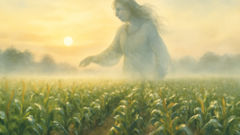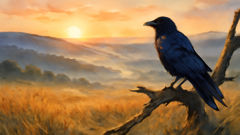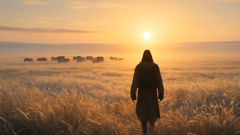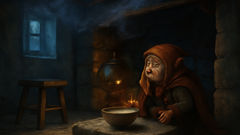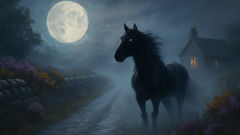Introduction
On the edge of the Great Plains, where summers lean into gold and the wind moves like a patient teacher through fields of tall corn, there lives a story told by elders and whispered in the ears of children who lean close to warm fires. The tale speaks not of treasure or conquest but of a spirit named the Corn Mother, a guardian whose breath fills the husks with life and whose heart breaks so that others may feast. Long before tractors clattered across the valley and markets began to hum with distant chatter, a people learned to read the land’s moods—the sudden cool that meant rain, the dry season that frightened the soil, the way seeds slept in the earth until a stir of warmth woke them. Into this world came the Corn Mother, not a god seated above, but a neighbor who walked with the corn as a farmer walks among his rows—present, patient, and undeniable. She wandered between communities like a caretaker of memory, listening to the chatter of roots and rain, watching children shove their hands into dark soil, and hearing the distant drumbeat of harvest festivals that kept the days anchored to hope. She did not demand worship or praise; she asked for care of the land, gratitude in the mouth after the first bite of bread, and honesty when the land faced hunger. When drought pressed its hollow fist into the valley, when frost whispered early warnings and the corn shrank its leaves in fear, the Corn Mother spoke with a voice that sounded like corn kernels cascading from a silo—soft, earnest, and unstoppable. She taught that every seed carries a story, that every ear of corn is a memory of weather and wind and the patience of a people who learned to wait for rain as if it were a lullaby. And so the legend begins with a simple act of presence: a motherly figure who tends the soil with gentle hands, who sings to seeds as they sleep, who honors pollinators as if they were old friends. She is not merely nourishment; she is the memory of the land’s generosity, the promise that the earth, if treated with care, will offer back its bread for winters and for seasons yet unborn. Her choice is not loud or dramatic in the way battles are, but quiet and unassailable: she gathers the breath of the fields into her own lungs, folds it into kernels, and plants the first harvest with a breath so warm that the earliest shoots feel her care before they feel the sun. In this way, the Corn Mother becomes both symbol and sacrament—the cycle by which soil, seed, and human hands tell a single story about endurance, reciprocity, and shared sustenance.
Section 1 — Seed of the Spirit
The earliest telling places the Corn Mother among the tribes who learned to live with the land rather than wage against it. In one village, perched near a lazy river that braided through the high grass, people woke to the soft clatter of drumbeats and the rustle of corn husks that sounded like whispered prayers. The elders spoke of a time when the soil remained bare and kindly weather refused to listen to human pleas. In those days the people gathered at the edge of a field and waited, not with impatience but with reverence, as if listening for a letter the earth was about to deliver. Then, from the dim air between dawn and light, she appeared: a woman-shaped figure formed of the pale gold of ripe corn, her hair a cascade of stalks, her dress a weave of green husks and leaf-brown threads. She spoke not with thunder but with the hum of busy pollinators and the soft creak of irrigation channels; her presence was a condition of possibility, a reminder that to plant well you must listen first to what the land is trying to tell you. This Seed of the Spirit, as she would be known, walked the furrows with a patient stride, touching the soil as if it were a living library. When she placed her palm upon the seed, the ground seemed to breathe, and a chorus of tiny roots stretched out like the lines of a map still being drawn. The elders say she taught the people to see corn as kin, to call each seed by its name and to trust that a season’s drought would be answered by a season’s rain if people held to their rituals. The children, who had always believed that seeds slept until they heard a song, learned to sing old tunes that spoke of soil and sun and water. The Corn Mother, in those days, did not claim a throne; she walked among the rows, counted the days with the farmers, and offered a quiet blessing at the moment a seed woke to green. The image remains of her hands cupping a handful of newly sprouted corn, her breath turning to frost on the tips of the leaves, a subtle reminder that life begins with belief and ends with memory. As the harvest moons turned, the village learned to plant with a patience that felt almost sacred—no rush, just a steady willingness to wait for the earth to reveal its gifts. And so the seeds learned to trust the hands that cared for them, and the Corn Mother’s Spirit settled deeper in the soil of the people’s memory.
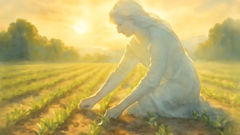
Section 2 — The Sacrifice
When seasons shifted and a harsh drought pressed the valley into silence, the people faced a banner of fear hanging over their roofs. Rivers ran low, granaries grew hollow, and the faces of farmers wore the gray of winter despite the calendar promising late summer heat. In the center of the village there rose a whispered answer: that the Corn Mother could become the grain herself, that she could breathe her life into the seeds so they would carry her strength into every stalk. The council of elders, once divided by petty frictions, found unity in the idea that a mother would give what she was made of if it meant the survival of the children who could not fetch rain from the sky. And so, in a night when stars burned bright and the air carried the smell of dust and possibility, the Corn Mother made her decision known to the dreaming minds of those who listened for signs. She walked into the heart of the cornfield, where the tallest stalks rose like pillars in a temple. Her voice, when it came, did not shout but moved across the waves of heat and grit, a warm tide that settled into each ear of corn. She offered herself as the kernel, a core that could feed a village through the long days of hunger. The people stood, not with celebration but with reverent stillness, feeling the weight of her gift and the gravity of their responsibility. The moment of sacrifice transformed the land; where there had been bare earth, the ground thickened with potential, as if the soil remembered its own vow to keep life ongoing. When the first rains returned, they did so not as a simple benevolence but as a sign that the earth had accepted the Corn Mother’s choice and would reward the people by turning her essence into sustenance. The kernels that filled every ear carried a faint memory of her breath, a trace of her courage, and a stubborn faith that community would not squander the gift but tend it with reverent hands. From that season onward, the harvest festival became a ritual of credit and humility: the community would tell the story of the sacrifice, share bread among neighbors, and plant with greater care, every seed a ceremony, every row a page of the legend. In more than one generation, the tale would travel beyond the river’s bend, crossing into towns where farmers spoke of soil as if it were a living creditor who required fair repayment. The Corn Mother’s sacrifice did not erase the drought, but it gave relief that felt like a blessing you could hold in your palm—soft, sweet, and enduring.
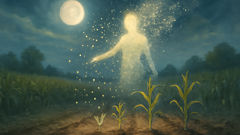
Section 3 — The Harvest and Remembering
As years fold into decades, the legend of the Corn Mother becomes a living practice rather than a memory alone. The people learn to listen to the soil’s hum—its steady, patient chorus—and to respond with care: crop rotation that respects the land; compost that returns what the field has given; irrigation that follows the lay of the land rather than the clock. In autumn, the village gathers not just to count ears but to count acts of generosity: a neighbor offers water to a field plundered by heat, a family shares cornmeal with a visitor who cannot afford bread, a grandmother teaches grandchildren the old songs that coax sweetness from the seeds. The Corn Mother, wherever a field lies, lives in every kernel that pops into pale gold on a summer day. Children dream of her as they walk to school past the cornfields; teenagers sketch murals on barn doors that blend her figure with the river and the wind; elders pass down the ritual words that invite the earth to remember and to repay. In the modern chapter of the tale, farmers still speak of drought as a partner in conversation with rain, a test that asks whether a people can hold fast to the memory of the sacrifice and translate it into sustainable practice. The land becomes a character too, one who does not demand obedience but reciprocity: when you nourish the soil, the soil remembers your care and returns more than you gave. And so the legend remains a current thread in a larger fabric: a reminder that sustenance is a shared act, that the sacrifices of one generation become the nourishment of many, and that the Corn Mother does not depart so much as she recedes into every seed’s promise, watching, guiding, and waiting for the next harvest season to begin.
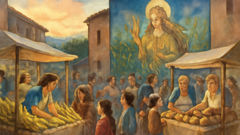
Conclusion
In the end, the Corn Mother is less a creature of myth and more a living practice. She remains in the quiet, daily acts of care—the careful tilling of soil, the patient waiting for rain, the sharing of bread with a hungry neighbor, the stories told to every new generation. The legend travels with the harvest, carried in sleeves of old coats and in the bright eyes of children who know that corn is more than a crop; it is a thread that connects people to one another and to the land that feeds them. When autumn winds rise and cornstalks rustle like gentle wings, those who remember the sacrifice feel a kinship with all who work the land. They know that the earth gives not freely but generously to those who tend it with respect, patience, and gratitude. And so the corn grows—tall, resilient, and bright—bearing the memory of a mother who chose life for her people, and in that choice, created a future where bread and grain become a shared covenant. The legend endures because it is practical and hopeful: a reminder to act with humility, to teach the young, to defend the soil, and to honor the sacrifice that nourishes every winter’s table. In every harvest, in every loaf of bread, in every small seed planted with patient hands, the Corn Mother lives on, a guardian of life who sacrificed herself so that life would continue, time after time, season after season.

